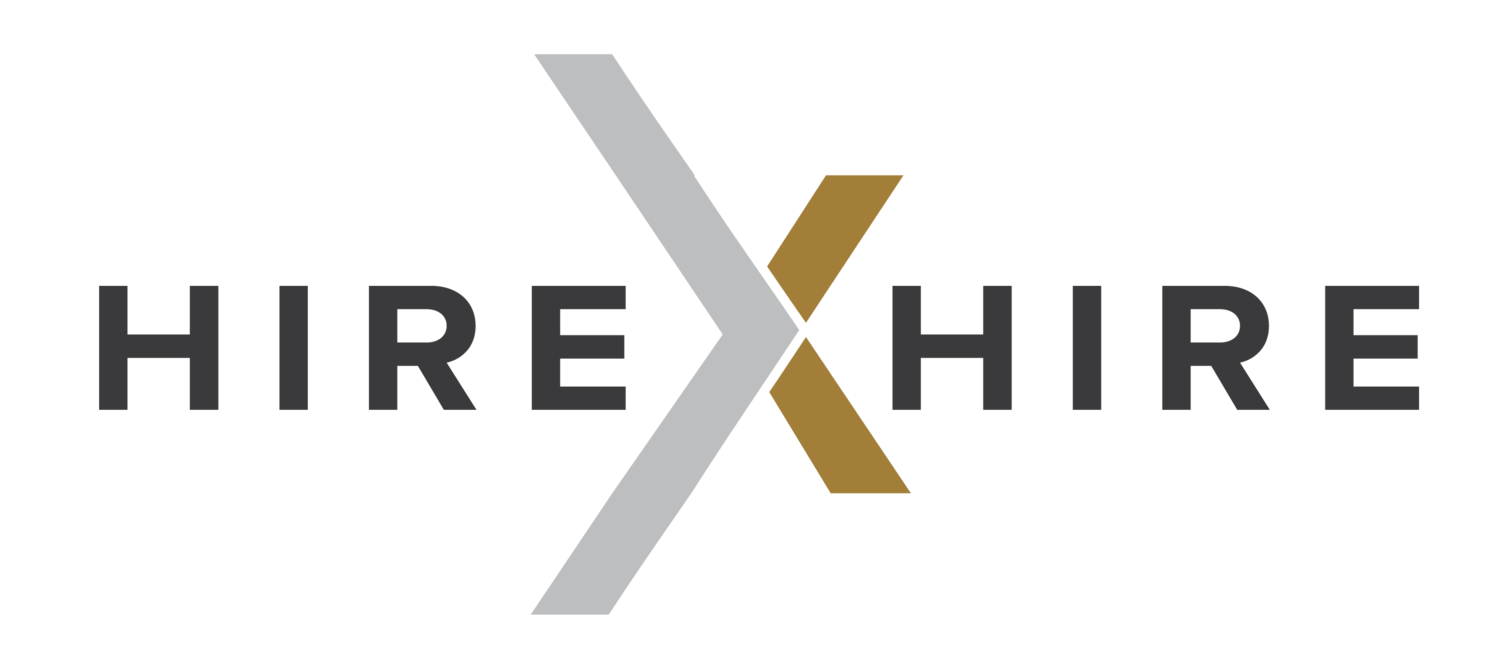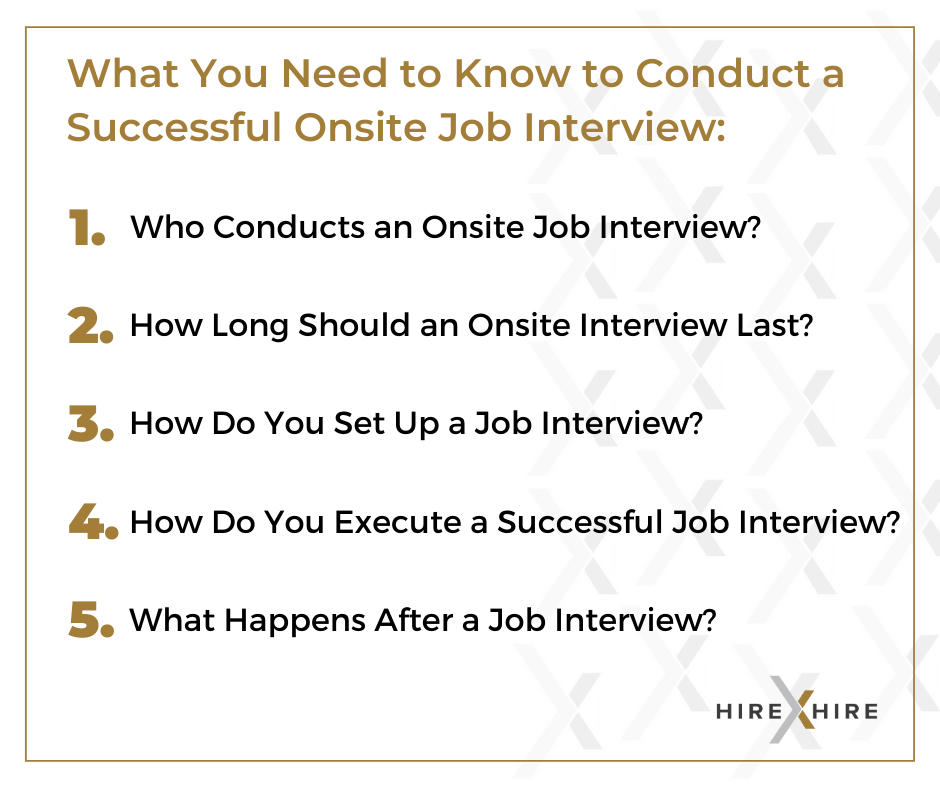Recruiting Framework Step 3: Master Onsite Interviews
This is Step 3 of a five-part series on building and managing your pragmatic recruiting framework. Click to read the overview to all five steps here, Step 1: Build Your Talent Pipeline here, or Step 2: Narrow Your Funnel with Phone Interviews here.
Step 3: Master Onsite Interviews
How to Conduct a Successful Job Interview that results in productive outcomes
You could say things are getting serious. It’s exciting and nerve-wracking for both parties. It’s time for the onsite interview.
You’ve already whittled down your talent pipeline twice: once when digitally sifting through the top of funnel resumes and another when conducting phone screens with candidates.
Now you’re down to a shortlist of eligible prospects. Any one of these candidates could be your next employee.
In its simplest form, the purpose of an in-person interview is to invite a candidate to meet with your team to have a conversation about a job role within your organization. But, let’s be real; it’s never that simple. The onsite interview is an essential step of your recruitment framework to find the right talent, who your team collectively agrees upon, and who wants to join your company in return.
There are some basic guidelines, processes, and best practices to execute productive in-person interviews. We’ve outlined what you need to know to conduct a successful job interview below.
Who Conducts an Onsite Job Interview?
How Many People Should be Involved?
A very general rule of thumb is to have three to five team members interview each candidate. Executive or senior-level management positions are exceptions to this rule. More than five interviewers will create an unnecessarily cumbersome interview process for most positions.
Who Should be Included on the Hiring Team?
In-person job interviews should be conducted by a group of company leaders, managers, and future colleagues who will work with the candidate once hired. This mix of individuals will be especially invested in finding the right person for the job.
Why is This Team Mix Important?
The exact titles of the hiring team will change, but it is important they’re not all from the same group or department. The hiring manager is a must, and a second persona to include in the interview process is a cross-functional team member with whom the position will work closely. And finally, bring in a member from leadership or upper management to round out the interview (typically, this is the hiring manager's manager or two levels up from the role being hired). If your organization has an HR or recruiting professional, it’s a good idea to include them in the onsite interview as well. She or he can go last in the interview line-up to address any of the candidate’s concerns and set expectations for what comes next in the interview process.
This mix of interviewers will balance the conversation, bringing varying perspectives on the candidate’s potential for success per the company’s needs. The hiring manager will evaluate a candidate’s skills and their fit culturally within the department. A cross-team collaborator can evaluate how the candidate will work with different teams and their communication style. And a senior management member can evaluate the long-term potential of a candidate to grow with the company.
How Long Should an Onsite Job Interview Last?
The length of an in-person job interview will certainly depend on the number of interviewers and the level of the position. In general, an interviewer needs at least 45 minutes to conduct a thorough analysis of the candidate’s fit for that interviewer's area of focus. A more senior position may require at least 60 minutes to facilitate a productive, in-depth discussion.
If you find the interview running long but don’t want to short-cut the conversation, be cognizant of a candidate’s human needs. Offer them water or coffee, and allow for short breaks between multiple interview sessions as needed.
How Do You Set Up a Job Interview?
Once a candidate has successfully progressed beyond the phone interview stage, their existing point-of-contact at your company should reach out via email to schedule the in-person interview.
You will have at least four schedules to consider when setting up the interview. So you may need to get creative to make it work. Request a few time slots that work for the candidate. Then see what works best for your team. An internal meeting may need to be pushed back, or a work block may be interrupted. Be flexible. Understanding and accommodating a candidate’s personal and professional situation is a hugely underrated part of providing a positive candidate experience.
Once you have agreed upon an interview date and time, lock it in. Confirm it over email and send a calendar invite to all parties. Make sure to include relevant information in the calendar invite – time, interviewers, address, etc. Include more thorough details in the confirmation email to the candidate. The more information you provide upfront, the more prepared the candidate can be for the discussion. In the email, include instructions for getting into your building and office. Pass along links to the interviewers’ LinkedIn profiles so the interviewee can prepare questions. Share links to other relevant pages, such as a culture blog or your company benefits. Save the graphic on the right if you want to keep the checklist handy.
Don’t forget that you’re also selling your company and workplace to the candidate. So make them feel as welcome as possible. Consider hosting a tour of the office before or after the interview. Make sure your team is prompt and prepared for the interview. And this next note is very important—over-communicate any changes to the original plan. Update the calendar details and confirm any changes through email.
How Do You Execute a Successful Job Interview?
The interview logistics are important, but success ultimately comes down to what happens in the interview room. The objective is to analyze the candidate’s fit for your company and position and sell them on working at your company for the foreseeable future. The challenge for many is strategically executing the objective. And the strategy must start before you even enter the interview room.
Before conversing with any candidates, the hiring team needs to align on collectively:
Main duties and expectations for the role.
Criteria for evaluating each candidate.
The importance of specific skills for a candidate: which skills are non-negotiable and which are “nice to have.”
Focus areas for each interviewer: hiring managers focus on hard skills; cross-team members analyze collaboration and communication style; leadership members hone in on potential and problem-solving skills.
Concerns from the phone interview. If there were any red flags raised in the phone interview or anything that needed to be probed more, interviewers should have a conversation about how they will dive further.
Before Conversing with a Candidate, the Hiring Team Members Each Need to:
Review materials provided by the applicant BEFORE the interview: resume, application, work samples, portfolio, social media profiles, etc.
Draft a list of questions specific to this candidate based on the materials they provided.
More preparation equals a more productive conversation with the candidate.
Interviewers typically only have a short time with a candidate, so make them count! Come with that list of questions prepared based on your pre-interview meeting, and take notes as you go. If you have a follow-up question, write it down to ask the candidate after completing their thought. Don’t interrupt. We’ve said it before, and here it is again. The interview is also for the candidate to evaluate your company. So, leave time for the candidate to ask questions and for free form conversation.
If the interview is going well, take a longer moment to “sell” the job position and your company. Each hiring team member can share what brings you happiness at the company. And acknowledge specific experiences or skills that you consider a great fit between the candidate and the role. An office tour after a positive interview can go a long way with a candidate, alleviating some of the formality and allowing a candidate to visualize him or herself working at your company.
What Happens After a Job Interview?
Within 48 hours post-interview, the hiring team should reconvene for a round-table discussion. Each interviewer should come prepared with candidate feedback, both positive and negative. The discussion should be about a candidate’s skills, cultural fit, experiences, and anything else important. Interviewers should also be prepared to recommend a HIRE or NO HIRE decision for the candidate.
Round-table discussions are important for several reasons. First, it holds interviewers accountable for providing insightful, valuable feedback on candidates. Second, it provides an opportunity to bring any misalignment between interviewers to the surface. For example, if one interviewer believes a candidate has sufficient technical skills to be successful, and another interviewer disagrees, the resulting dialogue leads to a resetting of expectations for future interviews.
Companies should conduct onsite interviews with multiple qualified candidates per open role. The round-table process should narrow down the field significantly. If you have multiple candidates interviewing in the span of one day (or even several days), round-tables can be constructed to debrief each candidate in one larger discussion. You will ideally wrap up the first round of onsite interviews with a small number of final candidates remaining in the running. These individuals will move onto the next step of the recruiting framework process, involving a role-related scenario.
In Conclusion
The onsite, in-person job interview is the highlight of the recruiting process. It’s absolutely crucial to the success of the recruiting process, as well as the building of a successful team and company. For a candidate, preparation is key. Preparation is also the crucial ingredient for a hiring team to conduct productive interviews. Preparation can be the difference between a successful interview and a failed one.












